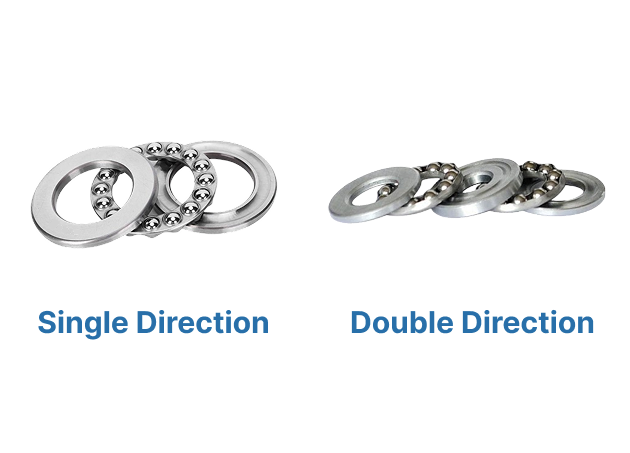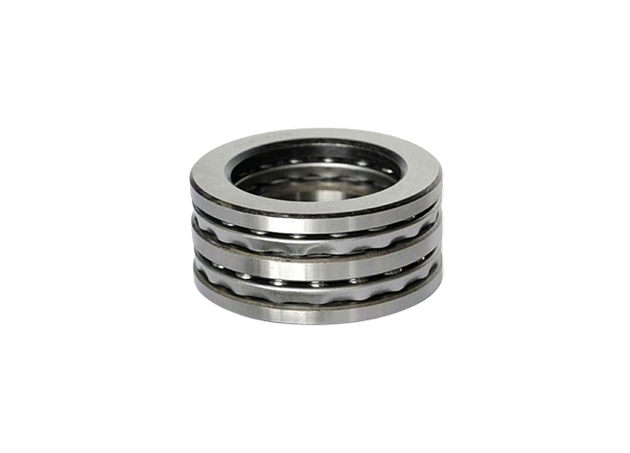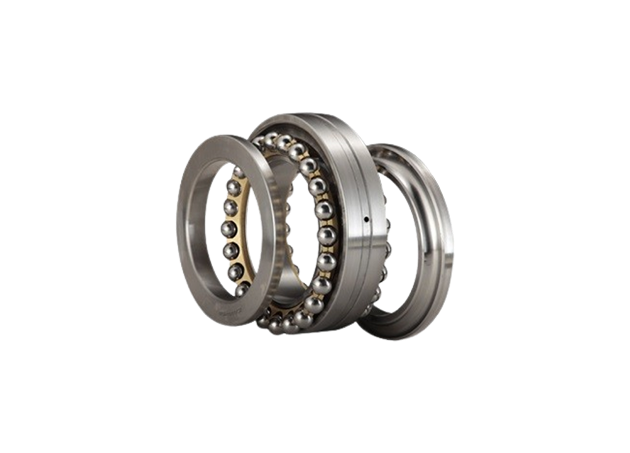Home / Product / Ball Bearings / Thrust Ball Bearings / Double Direction Thrust Ball Bearings
Double Direction Thrust Ball Bearings

Double direction thrust ball bearings are engineered to handle axial loads in both directions simultaneously.
These bearings are ideal for applications requiring high load capacity and stability, such as automotive transmissions and heavy machinery.
Their robust design ensures optimal performance, making them a reliable choice for demanding industrial environments.
Loading...
Total 57 Results
Part Number
Bore Dia
Outer Dia
Width
Chamfer Dimension Housing Washer
Chamfer Dimension Shaft Washer
Inner Dia Housing Washer
Cage Material
Dynamic Thrust Load
Static Thrust Load
Max Speed
Weight
52222
95 mm
160 mm
67 mm
1.1 mm
1 mm
113 mm
Stainless Steel
28125 lbf
82125 lbf
1800 rpm
4.65 kg
52224
100 mm
170 mm
68 mm
1.1 mm
1.1 mm
123 mm
Stainless Steel
28575 lbf
87750 lbf
1700 rpm
5.25 kg
52226
110 mm
190 mm
80 mm
1.5 mm
1.1 mm
133 mm
Stainless Steel
40950 lbf
131625 lbf
1500 rpm
8 kg
52228
120 mm
200 mm
81 mm
1.5 mm
1.1 mm
143 mm
Stainless Steel
48600 lbf
150750 lbf
1400 rpm
8.65 kg
52230 M
130 mm
215 mm
89 mm
1.5 mm
1.1 mm
153 mm
Brass
55575 lbf
180000 lbf
1300 rpm
11.5 kg
52232 M
140 mm
225 mm
90 mm
1.5 mm
1.1 mm
163 mm
Brass
55575 lbf
180000 lbf
1300 rpm
11.4 kg
52234 M
150 mm
240 mm
97 mm
1.5 mm
1.1 mm
173 mm
Brass
63225 lbf
220500 lbf
1200 rpm
15 kg

Unique Bidirectional Load-Carrying Capacity
The structure of a double direction thrust ball bearing is unique, consisting of two opposing rows of balls. These rows share the same cage and bearing housing washer (also known as the seat washer).
This sandwich-like design is the key difference between double direction and single direction thrust ball bearings. Unlike the single direction type, the shaft washers and housing washers of a double direction thrust ball bearing each have their own raceways, allowing the bearing to support pure axial loads from both directions.
Therefore, if your main requirement is to handle axial forces coming from both directions, this type is your ideal choice.
The Ideal Choice for Pure Axial Loads
Unlike angular contact bearings, which are designed to handle combined loads, double direction thrust ball bearings are almost exclusively engineered to support axial loads.
Free from the influence of radial forces, they manage axial loads with high efficiency, ensuring smooth and precise machine performance. This makes them a popular choice in applications such as machine tool spindles, screw drive systems, and high-precision rotary mechanisms.
If your equipment demands accurate positioning without the need for high-speed operation, double direction thrust ball bearings are an excellent solution.


Minimum Load Requirements
To ensure proper operation, double direction thrust ball bearings—like ball and roller bearings—must be bear a minimum load, especially under high speeds, rapid acceleration, or rapid changes in load direction.
In such conditions, the inertia of the balls and cage, along with internal lubricant friction, can negatively affect bearing performance. This may result in harmful sliding between the balls and raceways.
When starting at low temperatures or using high-viscosity lubricants, a higher minimum load may be required. In most cases, the weight supported by the bearing and any external forces—particularly in vertical shaft applications—already exceed the minimum load requirement. If not, a preload should be applied, such as using a spring mechanism.
FREQUENTLY ASKED QUESTIONS

Can I use double direction thrust ball bearings if my equipment needs to support very light radial loads?
No, double direction thrust ball bearings are designed exclusively for axial loads(thrust load). If subjected to radial loads, the bearing may be damaged. Even very light radial forces can negatively impact the bearing’s service life. Therefore, if both radial and axial loads are present, it's recommended to use a suitable type of angular contact bearing.
Are double direction thrust ball bearings suitable for high-speed operation?
No, they are not suitable for high-speed operation.
Due to the influence of centrifugal force, the rotational speed of thrust ball bearings is generally lower than that of radial bearings. Excessive speed can lead to slippage or increased wear. You can find detailed information about max speeds on the product detail pages of our catalog.
How can I find the bearing model I need on your website?
You can click the search button at the top right corner of the website to directly search for the specific model you need.
Alternatively, you can browse through the product categories step by step to find the desired ball bearing or roller bearing.
If you need further assistance, feel free to contact us directly.